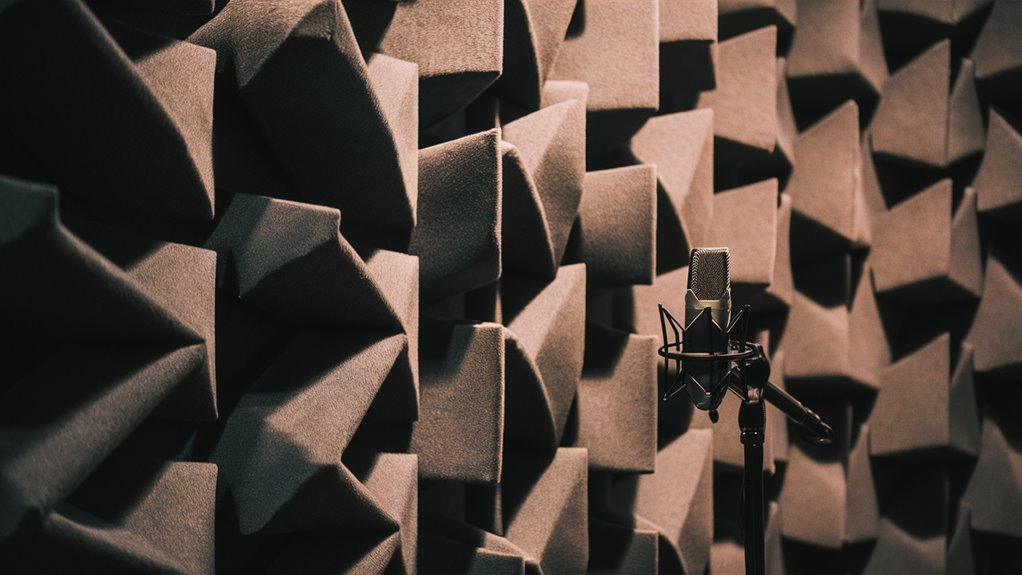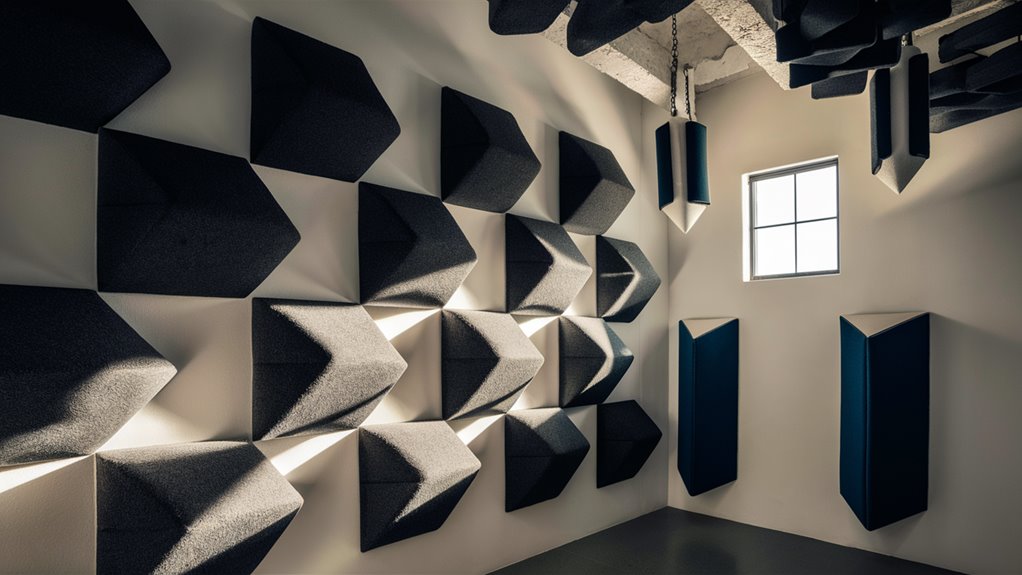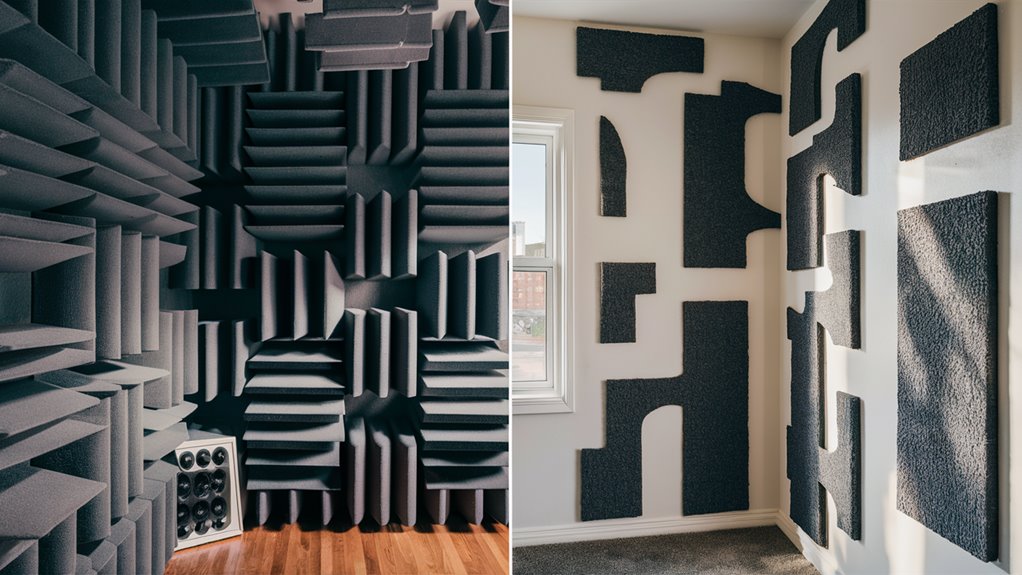
Making Rooms Quiet: A Full Guide to Great Sound

To make the best sound area, you need a full plan for keeping noise out that looks at both how sound moves and how it acts. The best way mixes heavy barriers, materials that soak up sound, and careful setup ways to reach top-notch results.
Key Parts of Making a Room Quiet
First do a deep check for places where sound gets through, like:
- Door and window seals
- Electrical outlets
- HVAC ducting
- Wall-floor edges
Ways Pros Treat Sound
Use these tested fixes for better noise control:
- Two layers of drywall with Green Glue
- Smart placing of panels at key echo points
- Bass traps in corners
- Checking and tuning sound levels
Getting the Best Sound Control
For the best results, add:
- Thick material barriers to block noise
- Special membrane systems for better isolation
- Panels that catch certain sound types
- Analyzing room mode for best material placement
Check your results with pro tools for measuring sound and change your setup based on the room’s needs and sound data. This careful method to managing noise ensures great sound performance at all sound levels 호치민 밤문화
Basics of Room Sound
Main Ideas of How Sound Moves
how sound mixes in a space comes from three key actions: bouncing, taking in, and spreading. Understanding these basic sound ideas is key to get the best noise control and treatment of a room.
How Sound Acts
Sound bouncing is when noise hits hard, flat parts like walls, windows, and floors. While these echos are good in big music places, they can make unwanted echo and ringing in smaller spots like home studios.
Sound taking in changes noise to heat using special materials and panels. Spreading moves sound in many ways, helping to handle noise focusing and stopping bad steady noise waves.
Room Shape and Sound
Room size changes how sound acts a lot. Walls facing each other often make back and forth echoes, while room modes happen at set sound levels based on the room’s size.
These steady sound levels set up clear patterns of sound help and stop in the room. Good sound treating needs smart placing of materials to get a good mix of bouncing, taking in, and spreading based on the room’s own needs and how it will be used.
Key Materials for Keeping Noise Out
Important Materials for Keeping Noise Out
Learning the Basics of Noise Control
Sound taking in and noise blocking each have special roles in treating noise.
Ways to Treat Walls and Ceilings
- Flexible channels with two layers of 5/8-inch drywall make a strong break for keeping noise out.
- Green Glue changes sound to heat through its stretchy parts when put between drywall layers.
- Heavy mineral wool at 6 pounds per cubic foot, set inside wall gaps, is great at lowering noise moving through fits your group ensures the perfect night out
Keeping Floors and Windows Quiet
- Underlayers like cork and rubber mats need at least 6mm thickness for best work.
- Layered glass windows with mixed layer thickness show better noise isolation than single-layer types.
- Acoustic caulk for closing gaps and strips for weather for doors finish a full noise control setup.
Ways to Put Materials Right
The right mix of materials and smart placing make noise control work well. Important spots include:
- Wall-floor edges
- Window edges
- Door frames
- HVAC gaps
- Electrical outlets
Usual Spots for Noise to Get Through
Typical Spots for Noise to Get Through in Buildings

Main Paths for Noise to Come In
- Noise coming in happens through a lot of weak spots in building make-up, even when main areas are well soundproofed.
- Windows and doors are big paths for noise, with edges around them being a big problem.
- Even tiny gaps like 1/8 inch around frames can make soundproofing work half as well.
- Electrical outlets and switch boxes make direct noise paths through walls.
- HVAC systems act like noise carriers between rooms.
Hidden Spots Where Sound Gets Through
- Ceiling holes including lights, bits, and fans often make clear noise paths to rooms next door.
- Edge of floor and walls and corners often have hidden gaps, really in old buildings affected by settling.
Where Building Parts Meet
- Plumbing holes under sinks and behind bathroom setups make big noise paths.
- Cable and web holes through outer walls often don’t have good noise block.
- Baseboards and top trim can hide gaps where noise gets through, while places where wall stuff changes make unplanned noise paths.
Key Building Spots
Places where different building materials meet often have weak sound spots, needing special focus during soundproofing. These building joins and material meeting points can make noise paths that skip main noise stops.
Key Machine System Holes
- HVAC ducting, air systems, and machine openings act as main noise paths between floors and rooms, needing special noise treating to keep sound block good.
Pro Setup Vs Do It Yourself
Pro Setup vs Do It Yourself: Picking What’s Best
Pro Noise Control Setup
- Pro sound setups give top results through special skills, good gear, and lots of experience with tricky noise systems.
- Certified workers handle setting up of heavy vinyl barriers, sound panels, and flexible channel systems with care and technical know-how.
- Their deep knowledge of how noise moves and noise treating makes sure you get the best quiet.
Do It Yourself Noise Fixing
- Do It Yourself noise projects can well handle basic noise needs in homes.
- Easy Do It Yourself tasks include:
- Putting in strips for weather and door seals
- Hanging ready-made sound panels
- Putting on noise-dampening stuff
- Closing gaps and air leaks
- Adding heavy barriers to walls
When to Pick Pro Setup
- Pro setup is must-have for:
- Recording studios
- Home theaters
- Work places
- Many-room noise fixing
- Setting floating floors
- Walls that don’t touch
- Tricky HVAC noise fixes
Think About Costs and What You Get Back
- Though pro soundproofing costs more at first, it stops costly mistakes and redoing work.
- Mistakes in Do It Yourself often need a pro to fix, which can cost more than if you had a pro do it first.
- Think about long-lasting worth and what you need when picking between pro and Do It Yourself ways.
Checking How Your Room Sounds
Testing How Your Room Sounds
Pro Ways to Check Sound
- Checking sound levels is key to see if sound changes are working.
- Needed tools are a right sound level tool, sound to check with, and a planned way to measure.
- Full checks need both inside and outside checks at many key spots to get the right start levels.
Doing Sound Checks
- Make controlled noise with a set speaker system or pro sound maker at set sound levels and loudness.
- Put your sound checking tools at planned check spots, writing exact sound level numbers all through the space.
- Check over the full sound range – including low, middle, and high sounds – as noise control changes a lot at different sound lengths.
Looking at How Much Sound is Cut
- Work out key sound numbers like the Noise Cut Number (NRC) and Sound Move Class (STC) by comparing levels before and after changes.
- Focus on trouble sound levels found during the first room check.
- Fix any found weak spots with more noise treating materials and noise block fixes to reach the best sound levels.
Key Sound Numbers
- How much sound is lost
- Impact noise rates
- Room echo time
- Sound range lines
- Room noise levels


